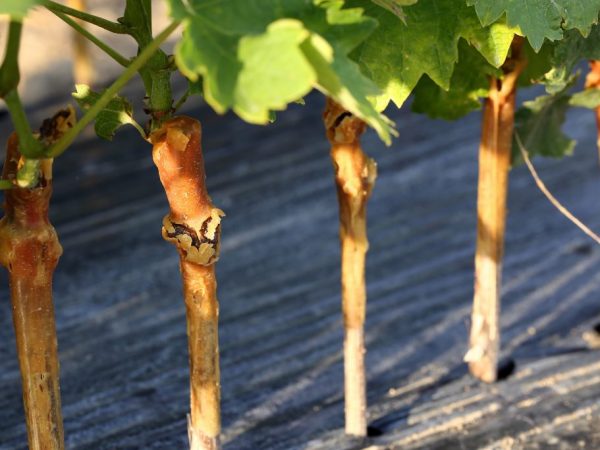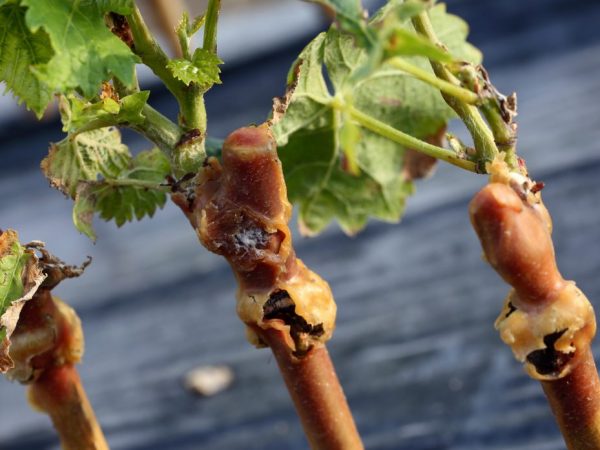Features of autumn grafting
Wanting to speed up the ripening of the grape crop or improve the characteristics of a certain variety, you will have to take care of the vegetative propagation of the plant. The best remedy is grafting in autumn.

Features of autumn grafting
Features of vaccination
Grafting is understood as a vegetative method of propagation or restoration of plants from damage. This method is also used in viticulture, when part of one plant is transferred and attached to the stem of another. The graft that is grafted is called a scion. And a new plant organism for him is a stock.
You can plant a culture in both spring and autumn. In summer, the procedure is rarely performed. In domestic climatic conditions, the most common procedure is carried out in the fall. Favorable terms - the end of the growing season. The culture is propagated until it enters a dormant stage.
There are several options for performing the procedure: budding, grafting into split, root, etc. Grafting of grapes in the fall is carried out in the stem.
Benefits of breeding grapes in the fall
Each vineyard owner decides for himself when to plant a particular bush. The main thing is to take into account the advantages that the procedure gives him. The most common reasons for conducting an agrotechnical operation are human dissatisfaction with the characteristics of the planted crop (yield, frost resistance, etc.) or the desire to restore a weak bush that has mechanical damage.
Benefits of grafting grapes in the fall:
- Increase in yield, external and taste characteristics of fruits.
- Increasing plant immunity to garden diseases.
- Changing the timing of fruit ripening. With the right choice of propagation materials, the ripening period will decrease.
- Rejuvenation of the old bush. That is, an increase in its life and fruiting.
It is required to plant grapes in autumn for every winegrower, both a beginner and an experienced specialist. Working in the garden will allow you to get a plant that will meet all human desires. It is only important to understand how such a procedure is carried out.
Preparatory activities
The efficiency of culture propagation depends on the quality of the scion and stock.
The wrong choice of material for the autumn propagation of grape crops has a detrimental effect on the result obtained.
The owner of the vineyard will have to prepare cuttings 55-60 cm long. The recommended diameter is 7-14 cm. The material is taken only from the fruit vine. It is important that there are 2 eyes on each cutting, the bark is healthy, yellow-brown.
In order for the plant to take root better, and the plant does not suffer from winter frosts, the cuttings are paraffinated:
- Collect 2 metal containers with water.
- One container is put on fire, the water is brought to a boil.
- Paraffin is placed in boiling water, melting it.
- The hot water is drained so that the paraffin remains in the container.
- The cuttings are dipped for 1-2 seconds in the molten substrate, taken out and dipped in cold water.
In cold water, paraffin hardens on the surface of the scion. All material is collected, dried and stored in a cool dry place until inoculation.
Autumn vaccination

You can plant grapes in early November.
The vaccination is carried out at the beginning of November, when the vegetative period ends. Before carrying out the reproduction procedure, cuttings are taken out and an incision is made at the end at an angle so that 1.5-2 cm remain to the nearest peephole. The procedure is performed with a disinfected garden knife.
Cuttings are placed in water until they are completely blooming. Prepare the necessary tools:
- garden knife;
- secateurs;
- an ax or hammer with a screwdriver;
- 2% solution of copper sulfate;
- twine.
All metal tools are treated with alcohol. Further, the reproduction procedure itself is carried out.
Step-by-step procedure
Before the grafting itself, a healthy plant is chosen, which will serve as a stock for the cuttings.
How to plant grapes in the fall:
- Most of the trunk is cut down. The distance from the root collar to the saw cut is no more than 12 cm.
- The cut site is treated with a solution of copper sulfate.
- Splitting is performed in the center of the cut site. Use a screwdriver with a hammer, a hatchet, or a chisel. The main thing is to make a recess in the stem, in size correlated with the diameter of the scion.
- Set the stock into the split so that the cut part goes deep into the hole obtained, and there is no more than 0.5 cm to the first bud of the cutting.
- The remaining empty space in the gap formed is stuffed with sawdust and chips of the same plant.
- The junction is wrapped with twine.
After the performed autumn procedure, the bush is watered with warm water and covered with sacking or polyethylene for the winter. With the onset of frost, the plant is additionally covered with spruce branches. It will also be effective to cover the bush with a layer of earth of 10-15 cm.
Recommendations
Garden work is carried out only in warm, dry weather, before the onset of frost.
For better engraftment, it will be important to remove the top layer of soil around the bush (rootstock).
Ways to speed up the engraftment of the scion to the stock:
- If the stock is large in diameter, it will be possible to plant several cuttings on it.
- After grafting, the soil is watered and loosened so that the roots of the bush are enriched with oxygen.
- If the cuttings have taken root, they are removed before the procedure.
Considering all these features, by the next autumn the grower will receive a full-fledged grape bush. The main thing is that in its first winter it is reliably sheltered from cold weather and precipitation.
Conclusion
Grafting in the fall has many benefits. Thanks to this procedure, it will be possible to improve the varietal characteristics of the crop or to rejuvenate an old plant. Considering all these recommendations, it will be possible to preserve some rare grape varieties.


